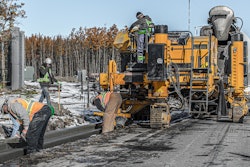
It’s a New Year, and we are facing the same workforce challenges. Think back to 2023—how often did you hear the following: “I’ve got more work than I know what to do with, but nobody to do it.” Or maybe, “I can’t find good help to save my life, these days everyone is just chasing dollars.” Or worse, “Nobody wants to work anymore.”
It’s a new year, but our industry kicked off 2024 facing the same age-old workforce challenges—the demand for skilled labor far exceeds the supply. Faced with limited time, resources, and insight into today’s job seekers, many companies begin to feel stuck. They’re painfully aware that the old tactics no longer work, but unsure of what needs to change.
BuildWitt has witnessed this pattern repeated for the last five years. Many of the best companies in America grapple with workforce challenges, some more successfully than others. The 2023 Ariat Dirt World Summit brought together 750 construction industry leaders from across the country, and the overwhelming focus of their conversations was — you guessed it — solving workforce challenges.
There are companies out there that are seemingly unaffected by workforce trends and don’t have a people problem, but it’s not because they got lucky. They’re taking some key actions, and we’ll share them here.
Hiring Won’t Fix the Problem
As an industry, we’ve gotten used to the words “workforce shortage.” While it's true there is a looming shortage, The National Center for Construction Education & Research (NCCER) has estimated that 41 percent of the current construction workforce will be retired by the year 2031—the struggle most contractors face currently isn’t hiring but retaining their existing employees.
Hiring is an understandable response because it’s actionable, easy to quantify, and places the focus on the employee rather than the employer—i.e. “Nobody wants to work anymore.”
However, the truth is that building a robust and sustainable team goes beyond recruitment. It hinges on retaining the invaluable talent already in your ranks.
Retention, the basic act of keeping your skilled workers within your fold, is the cornerstone of a stable and productive workforce. It's not just about filling gaps but about ensuring those gaps don’t appear in the first place. A revolving door of employees can be not only expensive but also disruptive to projects and company culture.
In a recent poll of BuildWitt followers on social media, construction workers aged 20 to 35 revealed that nearly 50% had changed jobs in the past two years. The reasons behind these job changes are as diverse as the industry itself:
● Sought better pay
● Entered new phases of life, requiring more time at home
● Sought a company invested in employee growth and training
● Fled bad leadership or simply felt undervalued
What's significant is that the demand for skilled workers in construction has reached an all-time high, giving today’s workforce newfound leverage. Workers now understand the power of saying "no" to unfavorable work environments—those that don’t meet the requirements listed above. It’s now the job of employers to make their companies worth saying "yes" to.
While money is an important part of the equation, other less tangible factors are at play. To attract high-value workers in today’s job market, it's no longer sufficient to offer competitive wages alone. Construction companies must craft environments where employees feel valued, respected, and empowered.
But it doesn’t end there. A culture of respect and empowerment will help get discerning applicants through the doors of your company. For them to stay and invest in the company long-term, they need a clear vision of what their career could look like.
Give Your People a Path for Growth
Imagine this scenario: you’ve managed to hire your dream employee and they show up to work on day one eager to contribute their skills and knowledge. They’re assigned their first task and quickly get the hang of it. Soon they’re showing interest in more advanced parts of the operation.
This is exactly the kind of employee you’ve been hoping to find. This individual is going somewhere, the only question is: how far? If the answer isn’t clearly laid out within your company, what choice does that individual have but to look for it somewhere else?
To retain valuable individuals, it's imperative to lay out a roadmap for their growth within your organization.
This path should be illuminated with opportunities for skill enhancement, leadership training, and career progression. By investing in your employees' development, you not only increase their job satisfaction but also foster a sense of loyalty and commitment.
Do NOT Underestimate Training
According to a BuildWitt survey of more than 600 Dirt World workers, “more training and learning opportunities” ranked second on a list of factors that would most increase job satisfaction, higher than schedule flexibility, more PTO, and a shorter commute.
The same poll showed a staggering 46% of respondents claiming they receive training once per year or less at their current job. This lack of training across our industry raises a significant concern as it directly impacts job satisfaction and employee retention. It also highlights a golden opportunity for employers to step up their training game.
Employee Growth Can Help Your Company Operate Better
Consider this: companies that prioritize employee development and offer a structured path for growth often outperform their competitors. They create a workplace where individuals are encouraged and incentivized to reach their full potential—meaning better overall performance.
As you contemplate your workforce strategy for 2024, remember that giving your people a path for growth isn’t just about retaining talent but also ensuring the long-term success of your organization.
Increase the Size of Your Talent Pool
Imagine your workforce as a sturdy bucket. In years past, the water you poured in often flowed right through the holes, representing high turnover rates and wasted resources. But you’re starting 2024 with a renewed focus on retention and growth, you've patched up those holes and strengthened your bucket. Now that it’s finally able to hold what you pour in, you want to fill it with good quality water—i.e. candidates.  As you contemplate your workforce strategy for 2024, remember that giving your people a path for growth isn’t just about retaining talent but also ensuring the long-term success of your organization.BuildWitt
As you contemplate your workforce strategy for 2024, remember that giving your people a path for growth isn’t just about retaining talent but also ensuring the long-term success of your organization.BuildWitt
Harness Social Media for Talent Attraction
To fill your bucket, you need to attract talent proactively. This is where social media steps into the spotlight. Social platforms have become invaluable tools for talent attraction, and the statistics speak for themselves. According to Glassdoor, 79% of job seekers use social media platforms in their job search. Statista reports that 302 billion Americans (93% of the country) actively use social media.
The key advantage of using social media for talent attraction is its ability to reach an audience you might not access through traditional means. By showcasing your company culture, projects, and the people who make it all happen, you begin to build trust and credibility. Workers who might not have considered your company—or the industry in general—may begin to see the work not just as a job but as something genuinely compelling.
Be Willing to Hire Inexperienced Candidates
Expanding your talent pool doesn't just involve attracting experienced professionals. It can also mean hiring less experienced candidates. In many cases, such individuals can bring fresh perspectives and a hunger to learn, which can be invaluable assets to your team.
When you have a well-defined training path in place, bringing in less experienced candidates becomes a viable strategy. You can provide them with the necessary guidance, mentorship, and hands-on training to quickly bring them up to speed.
Putting It Into Action
To recap: overcoming your workforce challenges in 2024 depends on retaining the valuable talent you already possess. The first step to retaining is building a people-focused culture that prioritizes growth and backs it up with training. You can expand your horizons by tapping into the vast potential of social media to attract talent and by hiring less experienced candidates who can flourish with the right guidance.
If we first retain our existing workforce, make them more efficient and effective, and strategically attract new talent, we can reduce the need for constant recruitment and the costs involved in those efforts.
The workforce challenges of 2024 can be conquered by empowering your current team, fostering growth, and embracing people who are unfamiliar with our industry.
Now, it's time to put these insights into action. Embrace the change, invest in your people, and watch as your construction endeavors reach new heights in the Dirt World of tomorrow.


















